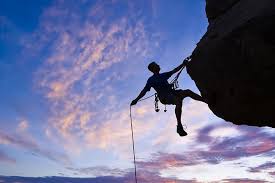Introduction
Rock climbing is an electrifying adventure that challenges both your physical prowess and mental acuity. Whether you’re a novice or a seasoned climber, there’s always room for improvement. To help you scale new heights and maximize the thrill of rock climbing, we’ve compiled ten expert tips that will enhance your climbing performance, safety, and enjoyment. So, buckle up your harness and get ready to embark on an exhilarating journey of climbing excellence!
- Caring for and Storing Your Climbing Gear and Ropes
Proper care and storage of your climbing gear are paramount to ensure its longevity and safety. Regularly inspect your gear for wear and tear, and replace any damaged or worn-out items. Store your gear in a cool, dry place away from direct sunlight to prevent degradation. Keep your climbing ropes away from dirt and sharp objects, and coil them neatly to avoid knots and kinks.
- Setting Up Climbing Anchors at the Climbing Site
Mastering the art of setting up climbing anchors is crucial for safety during climbs. Learn different anchor-building techniques and practice them in controlled environments before venturing to outdoor climbs. Seek guidance from experienced climbers or take a course to sharpen your skills in building sturdy and reliable anchors.
- Choosing a Climbing Route and Reading a Topographic Climbing Map
Selecting the right climbing route is essential for a successful and enjoyable climb. Evaluate the route’s difficulty level and ensure it aligns with your skills and experience. Familiarize yourself with topographic climbing maps to identify possible hazards, route variations, and escape routes in case of emergencies.
- Choosing the Correct Clothing to Wear
Dressing appropriately for climbing is essential for comfort and performance. Opt for moisture-wicking, quick-drying fabrics that offer a full range of motion. Wear layers to adapt to changing weather conditions. A climbing helmet is non-negotiable for head protection from falling debris.
- Choosing the Correct Climbing Shoes
Climbing shoes are your interface with the rock, and choosing the right pair can make a significant difference in your climbing performance. Select shoes that fit snugly without causing discomfort. For beginners, choose shoes with a flatter profile for all-around climbing versatility.
- Using Chalk for Grip
Chalk is your secret weapon for improving grip on holds, especially in sweaty conditions. Experiment with chalk balls, loose chalk, or liquid chalk to find what works best for you. Remember to brush off excess chalk marks to maintain the natural beauty of the climbing site.
- Climbing Terms and Lingo
Familiarize yourself with common climbing terms and lingo to effectively communicate with fellow climbers and understand route descriptions. Learning the language of climbing will enhance your overall climbing experience and make you feel like a true member of the climbing community.
- Carrying Food and Water With You While Climbing
Staying hydrated and fueled is vital for peak climbing performance. Always carry enough water and energy-rich snacks to sustain your energy levels during climbs. Portable and nutritious options like energy bars, nuts, and dried fruits are excellent choices.
FAQs – Your Rock Climbing Questions Answered
- How often should I inspect my climbing gear?
Inspect your climbing gear before every climbing session and perform a thorough inspection at least once a month. Regular checks ensure your gear is in optimal condition and safe for climbing.
- Can I use regular athletic shoes for climbing?
Regular athletic shoes lack the specialized design and grip needed for climbing. Invest in climbing-specific shoes for a safer and more enjoyable climbing experience.
- How do I overcome fear of falling while climbing?
Fear of falling is common among climbers. Gradually push your boundaries, practice falling in controlled environments, and trust your climbing partner to catch you. Building confidence over time will help reduce fear.
- Can I climb alone?
While climbing alone is not recommended, it can be done under certain circumstances by experienced climbers. Always prioritize safety and have a clear communication plan with someone on the ground.
Conclusion
With these expert tips in your climbing arsenal, you’re well-equipped to enhance your climbing prowess, safety, and enjoyment. Remember to prioritize proper gear care, anchor-setting skills, route selection, and dressing appropriately for climbs. Engage with the climbing community, embrace climbing lingo, and always carry adequate water and snacks to keep your energy levels high. Now, take these tips to heart, conquer new heights, and bask in the exhilarating world of rock climbing! Happy climbing!
